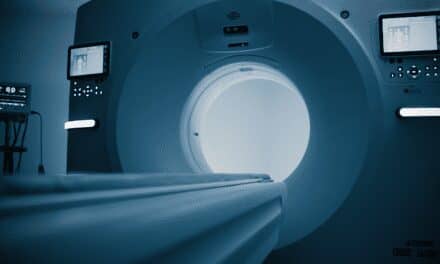 One of the biggest advances in the evolution of PACS that has occurred in the past few years is the ability to actually have products that can do the “C” in PACS?Communications. This feature enables the PACS to distribute images across an enterprise. One issue that continually arises is how to transfer images from the PACS to all the operating rooms (ORs). Individuals who work in the OR often complain about how they have to constantly print film to be taken to the OR. They want to know how PACS can address this objective.
One of the biggest advances in the evolution of PACS that has occurred in the past few years is the ability to actually have products that can do the “C” in PACS?Communications. This feature enables the PACS to distribute images across an enterprise. One issue that continually arises is how to transfer images from the PACS to all the operating rooms (ORs). Individuals who work in the OR often complain about how they have to constantly print film to be taken to the OR. They want to know how PACS can address this objective.
Recently, I completed some research with past clients about the distribution of the workstations we designed?what they actually implemented, what changed, and what was impacted as a result. What follows here is a review of the findings from my research.
Step One: Obtain the Necessary Viewing Stations
How many ORs do you have? What types of procedures are performed? Do any other surgical areas currently require films to be printed for viewing? Once you have identified how many viewing stations are needed, take that number and notify the appropriate vendor. Then, begin to prepare this portion of your budget.
Depending on the vendor, you will be supplied with the minimum hardware requirements and, typically, a recommended hardware configuration. Because you will be providing these PCs via IT, the IT department should be able to provide a good budgetary number for each one. I recommend purchasing at least the recommended RAM or, if financially feasible, one level of RAM higher. Ideally, you will want to provide for dual monitors at each of these Web-viewing stations in the OR. Budget accordingly?either with IT, or have the materials-management department provide you with a quote.
Should you get single-monitor viewing or go with a dual-monitor display? Dual monitor is the recommended and preferred configuration. The dual monitor removes limitations that are created when more than one image needs to be displayed at one time. A single monitor with a split screen for image display will not provide a film equivalent or improvement in efficiency, thereby causing the potential end-user to push back for film or creating a slower adaptation to soft-copy utilization.
However, a single monitor works for two reasons. The first is money?isn’t that always the way? If your budget cannot support dual monitor, then that obviously answers this question. Second is the space available. Many times, the ORs have very limited or no space for a dual-monitor setup; in fact, a single monitor can present issues.
A third possible reason for choosing single-monitor viewing is that if you have been distributing images via a Web server with a single monitor already and the clinical acceptance is strong, you might not have to provide a dual-monitor solution. Still, I will typically budget for all dual monitors for a conservative financial number.
Step Two: Deploy the Viewing Stations
Your Questions Answered |
|
Q: In your January 2006 column, you mention that salary is an issue that pushes PACS administrators to market-driven salaries elsewhere. Do you have a current market salary analysis for PACS administrators in the Midwest? ?Silvia Huitsing (Grand Rapids, Mich) A: To make adjustments by geographic location, I recommend to my clients that they pay approximately $1 per hour above the market salary for a lead CT or MRI technologist. This usually ends up being mid- to upper-$50,000s, and as high as $75,000. Most facilities promote someone internally. Editor’s Note: The August 2005 issue of Medical Imaging featured the results of our first-annual salary survey. We sorted our data such that we could determine an average salary of PACS administrators in Illinois, Indiana, Michigan, Ohio, and Wisconsin. Survey says: $67,611. Of course, many factors play into this number, including number of years in the field (more years = higher salary), gender (men still are typically paid more than women), and type of facility (our survey results show a higher salary for freestanding imaging centers). |
How will you deploy these viewing stations? Your facility has several options and, sometimes, several possible answers. Depending on your familiarity with all of the surgical areas, you will want to perform a walk-through of the areas and then meet with the department manager. The manager could recommend that you also meet with some key surgeons.
You will want to get answers to some key questions: What do they prefer? Do they have any experiences with competing facilities? What have those other facilities deployed? Is there any preference based on experience? What other clinical applications that support hardware have been or are beginning to be deployed that will impact the available wall or floor space?
Many facilities mount all monitors on the wall where the light boxes previously were. However, moving the images closer to the surgeon and surgical field offers inherent advantages. As I have tried to convey here in past editions of “Informatics Report,” we are always pushing to provide a solution that is demonstrably better than film. It should be remembered that all rooms are not the same, so what works for one room might not necessarily work for another room. Several vendors supply mobile carts for PC- and monitor-mounting configurations. Most of these vendors also provide wall-mounting options for viewing stations.
An additional option, which is costly and therefore not implemented frequently, is to boom-mount your monitors. Sometimes, it can be an option to use some existing monitors. Typically, the issue then becomes that those monitors have a clinical purpose and, if they ever need to be viewed at once, their use would not be a viable solution.
Step Three: Putting the Viewing Stations to Use
|
The viewing stations will need to be deployed into your surgical suites; therefore, you will need to plan or prepare to train the surgeons and the nurses to operate the system during the surgical procedures. Many times, the workload of preparing your radiology and emergency departments can consume all of your time in preparing to implement a PACS. Hence, the ORs are typically implemented a few weeks later. However, if you can install a few stations and begin to get your surgical staff excited and enthusiastic, then you will have taken another strong step forward in strengthening the overall impact of your technology and the delivery of patient care.
Michael Mack is VP of business development at the Thomas Group Ltd (Anaheim, Calif). Having more than 20 years of experience in the medical imaging industry, Mack now specializes in PACS planning and implementation.





